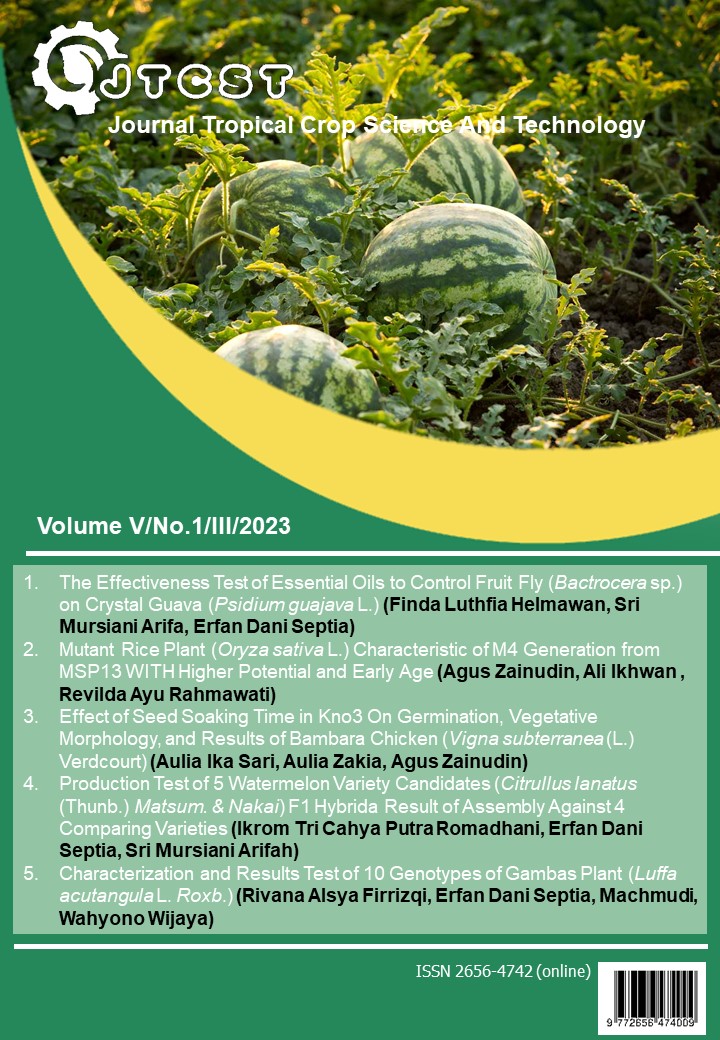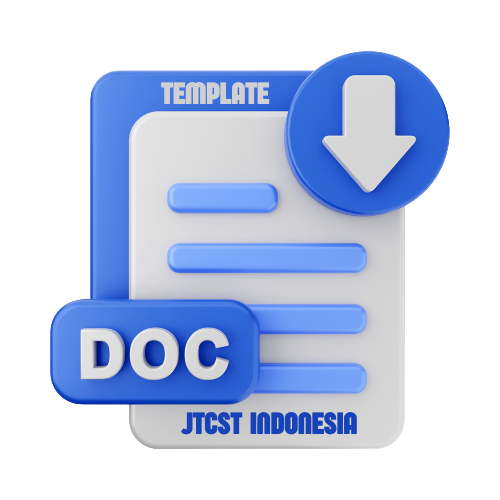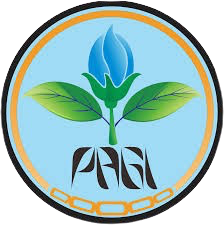Mutant Rice Plant (Oryza sativa L.) Characteristic of M4 Generation from MSP13 with Higher Potential and Early Age
DOI:
https://doi.org/10.22219/jtcst.v5i1.29720Keywords:
Rice Mutant, M4, Early AgeAbstract
The aim of this study was to obtain information about plant characteristics from the result of M4 generation from MSP13 rice mutants which has the potential to have higher production yields and early maturity than non-mutant rice, Ciherang and Inpari 32. The research was conducted from April to August 2022. The location of this research was done in the Pendem area of Campus III, University of Muhammadiyah Malang, Tegalgondo village, Karangploso, Malang. The result of the research on the characteristic of M4 generation rice mutants (Oryza sativa L.) which has the potential to have higher production yields and early maturity indicated that M4 mutant rice plants aged 98.00 days on average is very early maturing, non-mutant is in the early maturing category with an average harvest age of 97.66 days, meanwhile Ciherang is in the early maturing category with an average harvest age of 99.33 days and Inpari 32 has an average of 99.33 days so it is included in the early maturing category. Rice age at flowering, plant height, rice age at harvest, number of productive tillers, panicle length, number of grains in each panicle, weight of 100 grains of M4 mutant rice plants differed with each comparison variation. Cluster analysis results for each variety with the variables age of rice at flowering, plant height, age of rice at harvest, number of productive tillers, length of panicles, total number of grain per panicle, total grain weight per panicle, number of full grain per panicle, grain weight fruitful per panicle, and 100 grain weight consisting of 2 groups. The first group has a similarity level of 30,80% while the second group has a similarity level of 30,77% with a kinship of K1 and K2 of 0.00%.
Downloads
References
Asni, N., Novalinda, D. (2010). Analisa Mutu Fisik gabah Lahan Pasang Surut Melalui penanganan Panen dan pascapanen di Tingkat Petani Provinsi Jambi. 1452-1458.
Badan Pusat Statistik. 2015. Konsumsi RataRata per Kapita Seminggu Beberapa Macam Bahan makanan Penting.https://www.bps.go.id/linkTabelStatis/view/id/950.Balai Besar Padi. 2016. Prpinsip dan Populasi Sistem Jajar Tanam Legowo.
Bbpadi.litbang.pertanian.go.id.
Boceng, A., Haris, A., Tjoneng, A. 2016. “Character Of Local Rice Mutant „Ase Banda‟ As Result Of Gamma Ray Irradiation.” 3(1): 122–26.
Budiwati, Gusti Ayu Nyoman., Kriswiyanti, Eniek., Astarini, Ida Ayu. 2020. “Aspek Biologi Dan Hubungan Kekerabatan Padi Lokal (Oryza sativa L.) Di Desa Wongaya Gede Kecamatan Penebel, Kabupaten Tabanan, Bali.” Metamorfosa: Journal of Biological Sciences 6(2): 277. Donggulo, Candra V., Iskandar M. Lapanjang.,
Usman, Made. 2017. “Pertumbuhan Dan Hasil Tanaman Padi (Oryza sativa L.) Pada Berbagai Pola Jajar Legowo Dan Jarak Tanam.” J. Agroland 24(1): 27–35.Gusnarsih, Cici Khairi., Tobing, Cyccu., Pinem,
Mukhtar Iskandar. 2019. “Uji Ketahanan Beberapa Varietas Padi (Oryza sativa L.) Terhadap Hama Kepik Hitam Paraeucosmetus Pallicornis Dallas. (Hemiptera: Lygaeidae) Di Rumah Kasa.” Jurnal Agroekoteknologi FP USU 7(2): 262–71.
Hamdani, Kiki Kusyaeri. 2021. “Komparasi Potensi Hasil Dari Beberapa Varietas Unggul Padi Sawah.” Agric Vo. 33, No. 1 (200): 57–66.
Hidayanto, Hidayanto. 2019. “Rekomendasi Pemupukan Padi Sawah (Oryza sativa L.) Spesifik Lokasi Di Kecamatan Malinau - Kabupaten Malinau.” Jurnal Agroekoteknologi Tropika Lembab 2(1): 1.
Idawanni. 2014. “Persiapan Bibit Dan Cara Tanam Padi Sawah.” 2.
Lubis, R., A., Syawaluddin., Fitriana, D., K. 2017. “Pengaruh Umur Bibit Dan Teknik Penggenangan (Pengairan) Terhadap Pertumbuhan Dan Produksi Tanaman Padi Sawah (Oryza sativa L.).” Agrohita
(3(34)): 66–70.
Maemunnah.,Jeki., Mustakim., Samudin, Sakka., Handayani, Naning Tutik. 2021.“AGROLAND : Jurnal Ilmu-Ilmu Pertanian.” 28(3): 204–12.
Marbun, O. (2014). Keragaan pengembanngan Pengelolaan Hara Spesifik Lokasi (PHSL) di Jawa Barat. 87-97.
Noviana, Irma., Nurbaeti, Bebet., Haryati, Yati. 2016. “Potential Production and Development of Inpari 30 and Inpari 32 in West Java.” (September): 147–56.
Nuryanto, Bambang. 2018. “Pengendalian Penyakit Tanaman Padi Berwawasan Lingkungan Melalui Pengelolaan Komponen Epidemik.” Jurnal Penelitian dan Pengembangan Pertanian 37(1): 1.
Purwanto, Edi., Nandariyah., Yuwono, Suhadi Sapto., Yunindanova, Mercy Bientri. 2019. “Induced Mutation for Genetic Improvement in Black Rice Using Gamma-Ray.” Agrivita 41(2): 213–20.
Putro, Moh Yusup Ridho., Ardiarini, Noer Rahmi. 2018. “Uji Daya Hasil Pendahuluan Mutan Padi Merah (Oryza nivara L.) Di Dataran Medium Preliminary Yield Trial of Mutant Red Paddy (Oryza Nivara L.) in Medium Land.” Jurnal Produksi Tanaman 6(9): 2201–8.
Riyani, Rika., Purnamawati, Heni. 2019. “Pengaruh Metode Pemupukan Kalium Terhadap Pertumbuhan Dan Produktivitas Padi Gogo (Oryza sativa L.) Varietas IPB 9G.” Buletin Agrohorti 7(3): 363–74.
Rizal, Fathurrahman., Made, Usman. 2016. “Respons Padi Sawah Terhadap Waktu Pengolahan Tanah Dan Jarak Tanam Berbeda Dalam Sistem Tanam Legowo.” Jurnal Sains dan Teknologi Tadulako 5(2):
Sugiarto, R. 2018. “Pertumbuhan Dan Produksi Beberapa Varietas Padi (Oryza sativaL.) Pada Berbagai Sistem Tanam.” skripsi 2(2): 63–74.
Sugiarto, Rita., Kristanto, Budi Adi., Lukiwati, Dwi Retno. 2018. “Respon Pertumbuhan DanProduksi Padi Beras Merah (Oryza nivara) Terhadap Cekaman Kekeringan Pada Fase Pertumbuhan Berbeda Dan Pemupukan Nanosilika.” Journal of Agro Complex 2(2): 169.
Supriyanta, Whisnu Agung Suryanugraha, Kristamtini. 2017. “The Performance of Ten Local Rice (Oryza sativa L.) Cultivars of Yogyakarta Special Territor.” 6(4): 55–70.
Supriyanti, A., Supriyanta, Kristamtini. 2015. “Karakterisasi Dua Puluh Padi (Oryza sativa L.) Lokal Di Daerah Istimewa Yogyakarta.” Cybrarians Journal 4(37): 1–31.
Syuriani, Eka Erlinda., Kartahadimajja, Jaenudin., Sari, Miranda Ferwita., Hakim, Nurman Abdul. 2022. “Heritabilitas Karakter Fenotipik Dan Potensi Hasil Galur Padi Generasi F5.” Pertanian Agros 24(1): 106–14.
Tampoma, Wan Priando., Nurmala, Tati., Rachmadi, eddy. 2017. “Pengaruh Dosis Silika Terhadap Karakter Fisiologı Dan Hasil Tanaman Padi (Oryza sativa L.) Kultivar Lokal Poso (Kultıvar 36-Super Dan Tagolu).” Kultivasi 16(2): 320–25.
Wahdah, R., Rusmayadi, G., Zulhidiani, R. 2017. “Keragaan 25 Galur Mutan M7 Varietas Lokal Padi Di LAhan Pasang Surut Barito Kuala, Kalimantan Selatan.” In Prosiding Seminar Nasional Lahan Basah, , 187–94.
Wedastra, Made Suma., Suartha, I Dewa Gede., Catharina, Theresia Suzanna., Marini, Ida Ayu Ketut., Meikapasa, Ni Wayan Putu., Nopiari, Ida Ayu. 2020. “Pengendalian Hama Penyakit Terpadu UntukMengurangi Kerusakan Pada Tanaman Padi Di Desa Mekar Sari Kecamatan Gunung Sari.” Jurnal Gema Ngabdi 2(1): 88–94.
Widiarta, I. N., Suharto, H. (2016). Pengendalian hama dan Penyakit Tanaman Padi Secara Terpadu. In International Business Management (Vol. 10, Isuue 17, pp. 4006-4010)
Downloads
Published
How to Cite
Issue
Section
License
Copyright (c) 2023 Agus Zainudin, Ali Ikhwan, Revilda Ayu Rahmawati

This work is licensed under a Creative Commons Attribution-ShareAlike 4.0 International License.
Authors who publish with this journal agree to the following terms:
- Authors retain copyright and grant the journal right of first publication with the work simultaneously licensed under a Creative Commons Attribution License that allows others to share the work with an acknowledgement of the work's authorship and initial publication in this journal.
- Authors are able to enter into separate, additional contractual arrangements for the non-exclusive distribution of the journal's published version of the work (e.g., post it to an institutional repository or publish it in a book), with an acknowledgement of its initial publication in this journal.
- Authors are permitted and encouraged to post their work online (e.g., in institutional repositories or on their website) prior to and during the submission process, as it can lead to productive exchanges, as well as earlier and greater citation of published work (See The Effect of Open Access).











